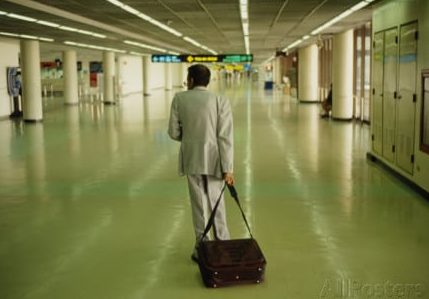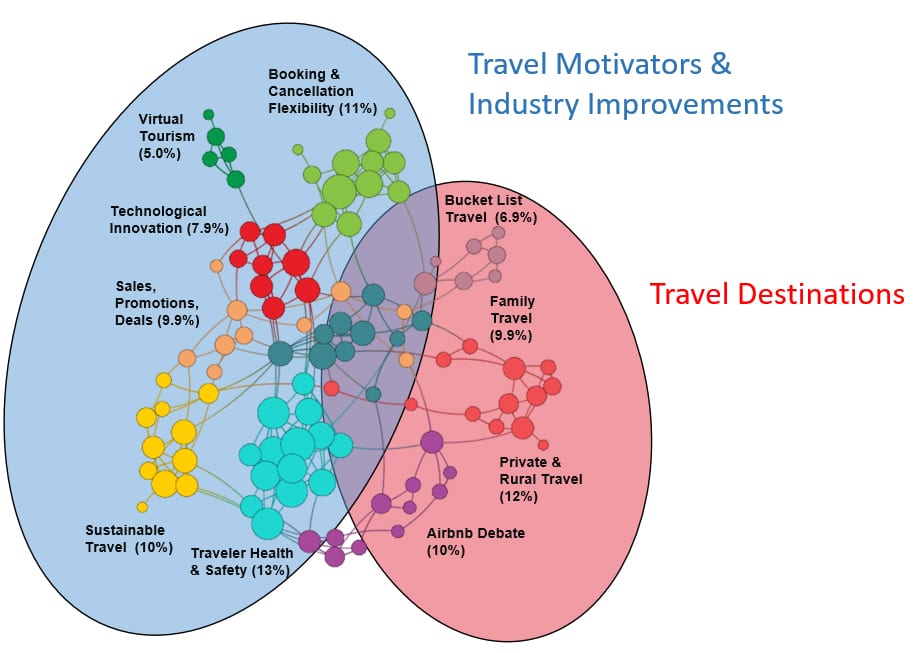

One of the most jarring consequences of a pandemic in our interconnected world has been the restriction of individual movement. The freedom to travel, locally or abroad, has been limited. Beyond canceled vacations and business trips, the travel, tourism and hospitality industries have been crippled. Only recently have experts begun imagining travel in a post-COVID-19 world.
To better understand predictions about the future of travel, APCO Worldwide’s digital team compiled an informal database of 100 forecasts published recently in more than 30 unique media outlets. Using a Natural Language Processing algorithm to group predictions by thematic similarity, the team analyzed common trends between the forecasts. Communicators in all industries can use similar predictive landscapes to understand trends.
In our travel example, two primary categories, or themes, emerged: Travel Motivators and Travel Destinations.
On the left, there are predictions that can be largely categorized as industry improvements necessary to motivate people to travel in the post-COVID-19 world.
Beyond the more obvious actions, such as increased promotions and cancellation flexibility, there also are predictions about promoting sustainable travel options that take environmental health into consideration. Emerging environmental and sustainability themes include predictions about reducing overtourism and carbon emissions of airplanes and cruise ships. In addition, there are efforts to ensure that natural landscapes are protected from people and people from nature (e.g., viruses).
Technological innovation also features prominently in these predictions about industry measures needed to encourage tourism, notably around health and safety issues. Robotics or automation services can be used to minimize human contact in airport queues and hotels, biometrics to track unhealthy travelers or radically rethinking interior design to accommodate social distancing within modes of transportation.
Several predictions speculate that shifts in destination choice will influence post-pandemic travel behavior. Instead of global cities, many experts believe travelers will prioritize rural or remote destinations off the beaten track, where proximity to nature could be perceived as being healthier.
Another cluster of predictions focused on bucket-list travel, and the potential increase in once-in-a-lifetime vacations following the current period of travel restrictions.
While there were numerous predictions concerning the future of economy accommodations, opinion was divided: some see private vacation rentals increasing, as long as the properties are isolated and close to home. Others think that smaller-scale private operators will be unable to guarantee sanitation in each lodging, as opposed to hotels, some of which are investing in apartment-style rental properties.

Health and Safety
Last, two themes dominate the center of the network and reveal priorities for future travel: health and safety and the expected increase in family travel.
Once travel restrictions are lifted, the first trip that many will take is to visit family and close friends. Some industry observers expect to see that trend evolve into increased multigenerational travel, as families rediscover the importance of spending time together and seek to save on travel costs.
Most important, all actors in the travel, tourism and hospitality sectors will need to adopt technologies and procedures to ensure the health and safety of potential travelers. Cleanliness and healthiness may soon even become key factors that airlines, hotels or tour groups use to differentiate their services from the competition.
Trend Mapping in Any Industry
While no one can predict the future, we can examine common themes in expert predictions and use them to map trends likely to shape the future of an industry. As this global crisis evolves, we can update this model to take into consideration changing predictions and revise projections accordingly.
Communicators can use prediction landscapes to understand wider industry trends that are likely to influence business strategy. In addition, communicators tracking forecasts will be better positioned to navigate changing circumstances and deliver a future-forward response.
CONTACT: [email protected]
